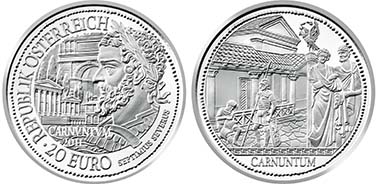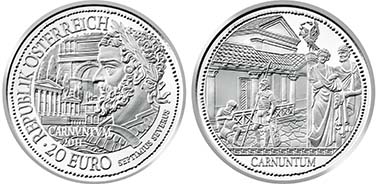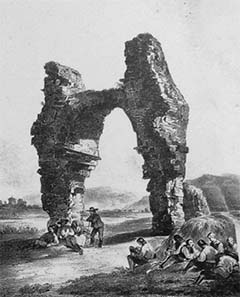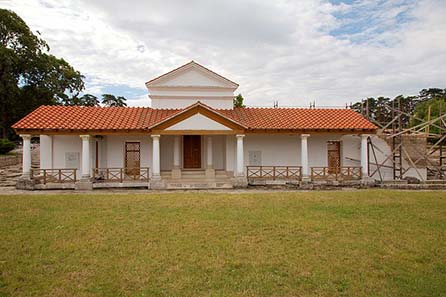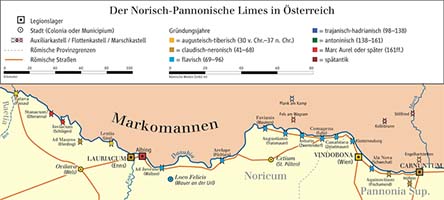April 14, 2011 – On April 13, 2011 the Austrian Mint will issue the third coin of the six coin silver series “Rome on the Danube”, recalling the days when Rome ruled the known western world and what is today Austria was part of its northern provinces.
The obverse of the new 20 euro silver coin depicts a profile portrait of the Emperor Septimius Severus, the governor of Pannonia, who was declared emperor by his troops in Carnuntum in A.D. 193.
The “Heathen Gate” – Engraving of Rudolf von Alts, ca. 1840. Source: Wikipedia.
Behind him is the massive arch of the “Heathen Gate” which stood at the crossroads of two major roads outside the city. The remnants of this massive gate can still be admired today. This side of the coin also depicts the country of issue “Republik Oesterreich”, Republic of Austria, the face value of 20 euros as well as the year of issue 2011. Helmut Andexlinger, a mint engraver designed the obverse side of the coin.
The Villa Urbana. Photo: Matthias Kabel / Wikipedia.
The reverse shows the Villa Urbana, one of the reconstructed buildings in the archaeological park at Carnuntum. The figures of legionaries and prosperous citizens noted in the foreground indicate Carnuntum’s importance as a commercial centre and a defensive base along the Danube border. Mint engraver Herbert Waehner designed the reverse of the coin.
Carnuntum located on the southern bank of the River Danube, close to today’s borders of Slovakia and Hungary, began life in 6 A.D. as winter quarters for troops under Tiberius (later Emperor), who was fighting a preventative war against the Germanic tribes of the Marcomanni. Around 35-40 A.D. Carnuntum became a garrison for the XV Legion Apollinaris who built the first permanent legionary fortress there. A civilian settlement grew up to the west of the fort and soon Carnuntum became the administrative capital of the province of Pannonia superior.
The course of the Limes. Source: Ziegelbrenner / Wikipedia.
Carnuntum housed not only the military and the civil administration for Pannonia, it also played a significant role in imperial history. The Emperor Hadrian (117-138) raised Carnuntum to the rank of a city (Municipium Aelium Carnuntum). Marcus Aurelius spent three years there during his wars against the Marcomanni and the Quadi, and wrote the second book of his philosophical work “Meditations” there. In A.D. 193 Septimius Severus was hailed as Emperor by the troops at Carnuntum. He in turn rewarded them by raising Carnuntum to the highest rank, that of a colonia. Again in 260 A.D. the troops there raised Regalianus to the purple (an expression of Roman majesty) in opposition to the Emperor Gallienus (260-268), but as Gallienus’s army approached, they decided it was safer to murder him. Regalianus survived long enough, however, to mint coins with his own countenance in Carnuntum. In November 308 the so-called Emperors’ Conference was summoned by Diocletian in Carnuntum. It established a new power organisation: the Tetrarchy or rule by four. In the East Galerius was declared Augustus with Maximinus as his Caesar (deputy) and in the West Licinius was made Augustus with Constantine (later the first Christian Emperor) as his Caesar.
Excavations of Carnuntum have been fairly extensive and today there is an archaeological park with not only ruined foundations and streets, but also reconstructions of various building for the public to visit. Two separate amphitheatres have been uncovered, one for the military and one for the town. In the mid 4th century Carnuntum seems to have suffered severe damage from an earthquake. When the Emperor Valentinian I (364-375) visited the once impressive provincial capital, an accompanying writer described it as a decayed and filthy nest! By the mid 5th century Carnuntum had experienced its share of barbarian invasions and migrations. The legionary fortress had been abandoned and like so many other Roman cities it fell prey to builders seeking stone and marble, till it slowly sunk into ruined oblivion.
The new silver coin has a face value of 20 euros, is struck in proof quality only and a maximum mintage of 50,000 pieces. The coins are struck in 900 fine silver and contain 18 grams of pure silver. Each coin has a diameter of 34 mm, is encapsulated and comes in box with an individually numbered certificate of authenticity.
A wooden case for the whole collection of six coins, decorated on the top with a facsimile of a Roman sestertius with a portrait of the Emperor Marcus Aurelius (161-180 A.D.) is available as well.
If you want to know more about the Austrian Mint, click here.
If you want to know more about the archaeological park of Carnuntum, click here.
If you want to see a short movie on Carnuntum, click here.
If you want to read the Meditations of Marc Aurel, click here.




